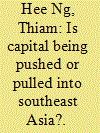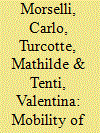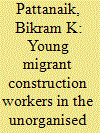| Srl | Item |
| 1 |
ID:
147329


|
|
|
|
|
| Summary/Abstract |
Although the Black student population in South Africa now amounts to 72% of student enrolments in higher education, the same trend is not experienced in early childhood education (ECE). Research suggests that cultural and linguistic differences between home communities and university settings as well as meeting the academic demands of an institution that is unfamiliar with students’ home languages and cultures can be overwhelming. Using the Force Field Model of Professional Development as a theoretical lens, the experiences of Black students are explored at a previous White university. Findings from focus group interviews indicate that financial restraints, unfamiliar teaching practices and language barriers are amongst the factors that are experienced as barriers and could serve as reasons for the low enrolment in ECE.
|
|
|
|
|
|
|
|
|
|
|
|
|
|
|
|
| 2 |
ID:
106399


|
|
|
|
|
| Publication |
2011.
|
| Summary/Abstract |
The paper aims to examine if push or pull factors are driving capital inflows into Southeast Asia. Using factor analysis, we find that there is one common factor that is driving capital flows into the region. This common factor, which can be interpreted as a push factor, accounts for 35 per cent of the variance of capital inflows into the region. Regression analysis shows that the push factor is strongly influenced by investors' risk perception and, to a lesser extent, by business cycle in the United States. This is worrying as risk perception can change quickly during periods of crisis and the capital inflows could suddenly turn into outflows, as seen during the recent global financial crisis.
|
|
|
|
|
|
|
|
|
|
|
|
|
|
|
|
| 3 |
ID:
106141


|
|
|
|
|
| Publication |
2011.
|
| Summary/Abstract |
This article reviews evidence from past research that addresses diverse themes and theories regarding shifts and patterns in the mobility of criminal groups. Our main objective is to identify push and pull factors that will help us understand how and why criminal groups, organisations or general organised crime patterns are present across a variety of settings (i.e. geographical locations, criminal markets and legitimate industries). Push factors refer to forces which drive criminal groups from a setting. Pull factors refer to forces which draw criminal groups to a setting. A distinction is also made between contexts in which offenders organise around available opportunities (the strategic context) and contexts in which opportunities induce greater organisational levels amongst offenders (the emergent context). The most general statement that can be formulated from the present exercise is that opportunities matter more than the group itself. What we demonstrate is that the problems concerning geographical locations, criminal markets and legitimate industries that are vulnerable to organised crime are persistent and stable over time. Groups that seize such opportunities, on the other hand, are transient and more than often short-lived. Aside from reviewing past research in search of such factors, we also apply the general understanding that emerges from our analysis to critically assess case studies that reflect popular images of organised crime threats in Canada during recent years. The concluding section identifies the key issues that must be addressed within this area.
|
|
|
|
|
|
|
|
|
|
|
|
|
|
|
|
| 4 |
ID:
087509


|
|
|
|
|
| Publication |
2009.
|
| Summary/Abstract |
This article constitutes an empirical socio-economic analysis based on a field study involving 1200 young unorganised workers found in the construction sector of the so-called tri-city of Chandigarh, Panchkula and Mohali. The main aim of the study was to examine the reasons why and how these young people had come to work in this urban environment, how they live and spend their money and what they perceive as their major problems. Based on the findings, the article argues that Indian policy makers, with specific regard to the urban unorganised labour sector, should take more-adequate measures for the protection of human rights of such migrant workers.
|
|
|
|
|
|
|
|
|
|
|
|
|
|
|
|